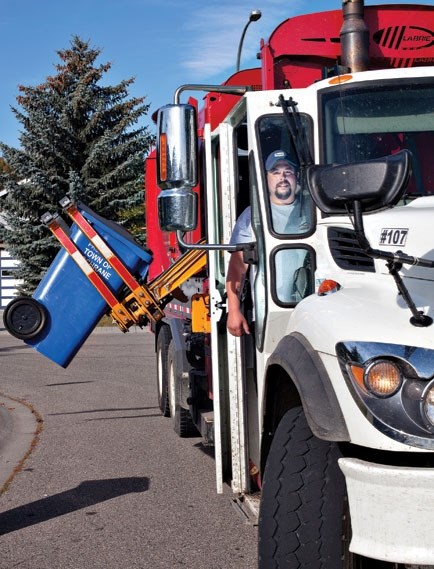No styrofoam. No glass.
As of Sept. 1, it’s been one year since Cochrane implemented the ‘blue bin’ recycling program, officially called, Roll With It Cochrane, and even though the program has exceeded the town’s expectations at improving household recycling by 50 per cent, there are still some limitations to it.
No styrofoam. No glass. These are the two program limitations that continue to bother Ingrid Schmidt — a 16-year Cochrane resident and avid recycler who feels the Roll With It Cochrane program is incomplete.
“We definitely benefit from a recycling program in Cochrane, however I’m still of the same opinion,” said Schmidt, who was last interviewed by the Eagle a year ago.
“We still use the recycling facility because of the limitations in what we can put in the blue bins . . . the limp excuses being used for glass are my biggest irritant”
Sharon Howland, waste and recycling manager for the Town of Cochrane said the demand just isn’t there for glass as a recycled product.
“Glass represents less than two per cent of the residential waste stream and expanded polystyrene (styrofoam) represents less than one per cent of the residential waste stream. With less than three per cent of materials in question, there really isn’t a lot of logic in sacrificing wonderful participation in a recycling collection program just because we cannot accept glass or EPS (styrofoam) in the program, especially since we continue to provide a drop-off program for those materials.”
The market demand for recyclable commodity glass isn’t there, according to the town; but according to Schmidt, the town isn’t doing their due diligence to find a solution.
Schmidt would like to see the town consider hiring people who may otherwise remain unemployed for separating materials out of the blue bins — instead of placing such restrictions on what recyclable materials can go in the bins.
The Roll With It Cochrane program cost remains the same for the coming year, at $17.40 per household per month.
Rick Deans, senior manager of infrastructure for the town, said that senior management is very pleased with the overall benefits of the program.
“Another benefit of the program has been control over debris being spread and airborne litter from garbage bags being torn apart by birds and other wildlife,” said Deans.
Deans also said that town administration will continue to be open to alternative solutions to the glass and styrofoam issue, as markets for these materials continue to develop.
Other changes or improvements to the Roll With It Cochrane program may be a result from council Oct. 22, where council will be presented with the ‘Zero Waste Framework’ document.
“This document will contain the long-term waste management plan for our community and provides direction for administration to explore future programming for the entire community, including single and multi-family programs, industrial, commercial and institutional programs, as well as construction and demolition sector options,” said Deans.
There are currently no curbside recycling options for these types of dwellings or businesses.
Howland said the improvement in average household recycling in just one year has been impressive.
“The Roll With It Cochrane program has been an outstanding success . . . we estimated a 50 per cent increase in the amount of material our community would divert from landfill — we have achieved our goal,” said Howland.
“At the curb, Cochrane residents have achieved a 33-35 per cent diversion rate, meaning that by weight, 33-35 per cent of what residents put out at the curb is recycling in their recycling cart and the other 65 per cent is waste in their waste cart sent for landfill . . . the average Cochrane household sets out 18 kilograms of recycling for collection per month. Of the remaining 65 per cent of material sent to landfill — approximately 10 per cent is still recyclable, 40 per cent is compostable and 15 per cent would be considered ‘other waste’.”
In comparison to the average Albertan, Cochranites rank high as recyclers.
“The average Cochrane resident will send approximately 140 kg of waste to landfill this year, whereas the average Albertan will send 280 kg of waste to landfill in 2012,” said Howland.
Another concern for Schmidt, who has a compost heap in her backyard is whether or not Cochrane will follow suit with Calgary’s Green Cart pilot program and implement a mandatory composting program in the future.
Where will this leave households who already take it upon themselves to compost?
“(If they implement such a program) will they allow people doing this on their own a credit?” wonders Schmidt.
• no grass, leaves or tree trimmings; these need to be taken to the Cochrane Eco Centre
• when rolling out garbage and recycling bins to the curb, ensure they are a safe distance from obstacles
• waste in the waste cart must be bagged; recycling in the recycling cart left loose
• remember the never-ending wind in Cochrane; roll the bins back when they have been emptied
• no glass; no styrofoam




